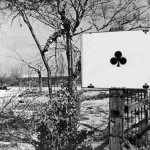Strong club system need at least two alternative openings for the hands beneath the strenght limit (17 or 16 points), and containing the club suit. These openings usually are 2♣, specific with the long suit, and undefined 1♦: with or without clubs or diamonds. The latter often affects – or is affected by – the 1NT opening. For example:
beneath the strenght limit (17 or 16 points), and containing the club suit. These openings usually are 2♣, specific with the long suit, and undefined 1♦: with or without clubs or diamonds. The latter often affects – or is affected by – the 1NT opening. For example:
– In the original Precision systems (1963, Charles Wei and Alan Truscott), 1♦ had three or more card; 1NT was a balanced hand with 13-15. Subsequent variants, of other players, upgraded the 1NT, that became 14-16 or 15-17, and, necessarily, downgraded the diamonds to two or one card suit (or even zero). This is the case of Rodwell-Meckstroth: they open 1♦ with two cards or a stiff honour, and 14-16 1NT (15-17 vulnerable).
– In Polish Club (e.g. Jassem-Martens), 1♦ grants always four cards and 1NT is worth 12-14.
– Sabine Auken and Daniela Von Arnim’s system opens 1♦ with three cards, or with two in the shape 3-3-2-5. They play mini 1NT (10-12), and four card majors.
A specification needs. The diamonds problem arises in Precision, in Meckwell and in Polish Club, mostly because the contemporary presence in those systems of the 5CM and the strong 1NT (15-17). Playing 4CM, as in Auken-Von Arnim, the only case in which diamonds are less than three, in fact, is the shape 3-3-2-5.
Glossary:
Strong 1NT is in the range 15-17 (or 16-18).
Weak 1NT is in the range 12-14.
Mini 1NT is in the range 10-12.
The Neapolitan Club System plays 4CM, however it needs great accuracy in this matter because it calls for full protection in NT contracts; this feature denies 1NT as a “container” for all that doesn’t fit the other openings; furthermore, the contract on minor is often the escaping from unprotected NT, then the uncertainty about clubs-diamonds must last as little as possible or, better, must do not exist at all. Neapolitan Club has two specific openings for clubs, 1NT and 2♣, and one less specific, 1♦, but not so vague as the modern systems allow.
We must also say that, as Neapolitan is a sound system, it needs good quality for the original bid. The biddable suit in the opening bid is normally any five card suit or a four one headed by K, or Q-9, or J-10. Bearing in mind these qualities – full protected NT, biddable suit, sound opening – we can sketch out the treatments and the reason of being of 1♦, 1NT and 2♣.
1♦ Opening bid
12-16 points and four or more cards, or three cards headed at least by Ace or King. The cards are three when the other suit isn’t biddable, or when it’s a club suit and the hand or the suit aren’t apt for 1NT or 2♣.
1NT Opening bid (with only clubs)
Balanced or semi balanced hand, 13-16 points. Four or five card club suit (exceptionally six), and no other suits; the shapes are 3-3-3-4 and 2(3)-2(3)-2(3)-5. All the suits must have a stopper; in 3-3-3-4 one suit can have not. Exceptions:
a) Six card club suit. The clubs must are weak and the other suits must have a good stopper.
Example: ♠QJx ♥KJ ♦AJ ♣Jxxxxx.
b) 3-3-2-5 without diamond stopper, but with 14-16 points (not 13).
Example: ♠AKx ♥KJx ♦xx ♣Axxxx.
2♣ Opening bid (always with clubs, one or two suited)
This opening originates from four kinds of hand, always with clubs:
a): one suited, 6+ cards, 11-16 points.
b): weak (11-12 points), 4M-6+ clubs.
c): 13-16 with strong five card suit. Example:
♠Axx ♥Kxx ♦xx ♣AKJxx. Here the clubs are enough strong that is possible avoid 1NT with the unguarded suit.
d) Two suited reverse hand with clubs
This is the way how the “Short diamond affair” has been solved in Neapolitan. It hasn’t been without a fee: the cost is the passing, sometime, with 12 or bad 13 points; such passes, anyway, are lined up with the character of the system, i.e. the soundness.
[stextbox id=”download”]Convention Cards source: http://www.ecatsbridge.com/[/stextbox]